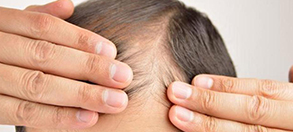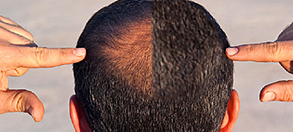Follicular multiplication, also known as hair cloning, is a developing treatment for androgenetic alopecia, or pattern baldness. Special cells, known as germinative hair follicle cells, are located in the bulb region of hair follicles in their growth stage. In hair cloning, a sample of a person’s germinative hair follicle cells is multiplied outside the body. This promising technology is set to change much of the hair restoration industry, and will allow patients with androgenetic alopecia another treatment option to overcome it.
Scientists have studied the regenerative properties of hair for many years. And now, they are on the precipice of creating a hair loss treatment that does not include follicular unit extraction (FUE) techniques. The cells are then implanted into the scalp for additional, natural, permanent hair. We will soon see this technology available for clinical application, and when it arrives Houston hair transplant patients will benefit greatly.
Dr. Goran Jezic is a leader in the field and is one of the most prolific hair transplantation surgeons. Call Houston Hair Transplantation Center in Houston,TX or Austin, TX for a personal consultation to discuss the best treatments for your hair loss by calling (713) 864-2300 or by filling in a simple online form.
Contents
The Hair Follicle
The hair follicle is the natural shaft from which hair grows. Its surrounding structures include:
- The arrector pili muscle that raises the hair in cold temperatures
- The dermal papilla, or root of the hair, that provides the hair’s vital blood supply
- The sebaceous gland that keeps the follicle well-lubricated
Hair follicles cycle through three key stages: anagen, catagen, and telogen, which represent the growing, transition, and resting phase of hair growth.
Find out more about the hair follicle on our blog.
Why Does Pattern Hair Loss Happen?
Hair loss can occur for many different reasons. Pattern hair loss occurs due to changes in hormones called androgens that disrupt the hair cycle, causing hair to shed at a faster than normal rate. Specifically, elevated levels of dihydrotestosterone (DHT) are strongly linked to androgenetic alopecia. But what if there was a non-FUE solution to this problem? And what are the current advances and limitations of follicular multiplication?
Is it Really Cloning?
“Hair cloning” is a term that broadly describes laboratory techniques used to solve the problem of hair loss. Technically, there is little difference between “true” hair cloning and the technique of hair multiplication for treating baldness. In both approaches, the goal is to produce an increased amount of donor hairs so that more patients can become candidates for restoration, regardless of donor density. The only basic difference is when the word “cloning” is used, it refers to starting with cells.
Current Hair Loss Treatments
Follicular multiplication is an evolving area of hair restoration science. But what options are available right now? Current hair loss treatments include FUE, follicular unit transplant (FUT/STRIP), and pharmacological interventions like finasteride and minoxidil.
Hair loss by the numbers. (1)
- Androgenetic alopecia is the most common form of hair loss in men.
- Pattern hair loss affects 30-50% of men by age 50.
- One fourth of men aged 40-55 have frontal hairline recession.
- Anger, depression, and anxiety are common emotional responses to hair loss.
Why wait? Receive personalized hair restoration advice at Houston Hair Transplant Center.
Contact us at (713) 864-2300 to book your one-on-one consultation.
Science of the Near Future
What is ECM?
The extracellular matrix (ECM) is a network in the deep layer of the dermis that serves as a reservoir of growth factors – important biological materials that stimulate cell growth. Other components of our natural ECM include the following. (2)
- Collagen: A structural tissue component
- Proteoglycans: Specially bonded proteins
- Elastin: Allows stretchiness in tissues
- Cell-Binding Glycoproteins: Basic components of ECM
MatriStem ECM ACell
MatriStem ACell is a tissue regeneration graft that enables doctors to inject ECM properties directly into a targeted area. This non-surgical device is used in multiple areas of medicine. And with the help of autologous conditioned plasma (ACP), in the near future, it is hoped it will play an important role in cell regeneration in hair restoration.
ACell provides an enhanced environment of growth factors to speed hair regrowth. In initial studies, hairs stimulated by ECM sometimes regenerate new hair. The hair is placed into the recipient area, and is partially derived from cells in the dermis. However, it is not yet clear whether this hair will be affected by androgens over time, or if hair will continue to thin.
It is also anticipated that ECM will facilitate the healing of the incision in the donor area after a hair transplant by its regenerative properties. The possibility of using a biologically-derived matrix to enable hair multiplication exists, but significant work remains in order for hair multiplication to become a practical treatment for hair loss in men and women.
Healing for Hair Cloning & Follicular Multiplication
The ECM is a natural biological material. It can be implanted at the site of an injury to stimulate healing. This type of healing is unique because it is specific to the site. This means, instead of the body producing scar tissue, the body heals by creating new original tissue. ACell MatriStem is a naturally occurring bio-scaffold, derived from porcine (pig) tissue. When MatriStem is placed into a surgical site or wound, it is resorbed and replaced with new, more supple tissue, rather than a firm scar.
ECM may be most beneficial in hair restoration because it promotes rapid tissue remodeling. By enabling neovascularization (the growth of new blood vessels) and recruiting host-derived mesenchymal cells (cells that lay down collagen and potentially can promote the formation of hair), ECM’s effects can potentially result in quicker healing of wounds and less scarring.
The Future of Hair Restoration?
As yet, few successful reports of medical cloning have come to light. And, none have yet been put into use for hair restoration. There are clearly many limitations that still exist to cloning in all areas of medicine, but Dr. Jezic is very hopeful that science is on the cusp of a follicular multiplication breakthrough.
The future of this technology is constantly developing, and hair restoration experts are eagerly awaiting its incorporation into standard hair loss treatments. This is one of the reasons that hair transplants in Houston may soon be less invasive than ever!
Want to stay connected with us and get regular updates on hair restoration in Houston and Austin, TX? Sign Up for our mailing list and stay informed about monthly specials at Houston Hair Transplantation Center.
Hair Transplantation Procedures
Although the science isn’t quite there yet with follicular multiplication techniques, there are some effective, minimally-invasive ways to achieve a fuller head of hair, and FUE is the current gold-standard treatment.
- ATERA FUE – ATERA is a technologically-advanced robotic follicular unit extraction device. Using small AI-guided punch incisions, ATERA extracts and harvests follicular grafts of between two and four hairs. Implantation produces natural-looking results and a minimal recovery period of just a few days, compared to conventional FUT techniques.
- NeoGraft – NeoGraft is a manual follicular unit extraction device that harnesses an expert hair restoration physician’s coordinated motor skills to select, extract, and harvest follicular units. Pinpoint accuracy and minimal downtime means NeoGraft is a popular alternative to traditional hair transplantation techniques.
- Hybrid Hair Restoration – Hybrid Hair Restoration is a minimally-invasive surgical treatment combined with the world’s leading hair restoration medications. Topical Minoxidil (Rogaine) or oral finasteride (Propecia) combined with FUE may mean the difference between successful hair restoration and outstanding hair restoration results!
- Facial Hair Transplants – FUE isn’t only for the scalp! Now, men can achieve thicker eyebrows or a fuller beard and/or mustache with Dr. Jezic’s help. Facial hair transplantation is a treatment method that is particularly effective for men who struggle to grow an even beard, or those who wish to “fill in” eyebrow patchiness, helping patients achieve better facial symmetry and more masculine features.
- Female Hair Transplants – Female hair loss is more common than most people realize. But help is at hand with a female-oriented FUE treatment plan. Female pattern hair loss looks different to men’s hair loss and requires specific, personalized procedures. With Dr. Jezic’s wealth of experience, female patients struggling with hair loss can re-energize hair growth and regain confidence.
Cost of a Hair Transplant in Houston, TX
Every treatment plan for hair loss is unique to the individual. FUE or ACP as standalone treatments may be used, or a hybrid treatment plan that incorporates hair regrowth medications. Because of this, the cost of your care will be calculated after your personal consultation with Dr. Jezic. Book your individual consultation with one of Texas’ leading hair transplantation surgeons by calling us directly at (713) 864-2300 or fill out a form online for more details.
References
- Winters SJ. Laboratory Assessment of Testicular Function. MDText.com, Inc.; 2020. Accessed February 6, 2023. https://www.ncbi.nlm.nih.gov/books/NBK279145/?report=reader
- Yue B. Biology of the Extracellular Matrix. Journal of Glaucoma. 2014;23(8):S20-S23. doi:https://doi.org/10.1097/ijg.0000000000000108



